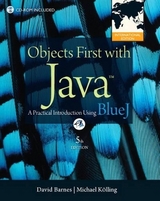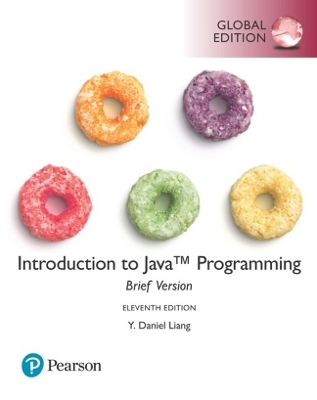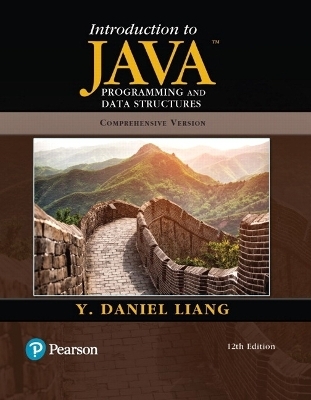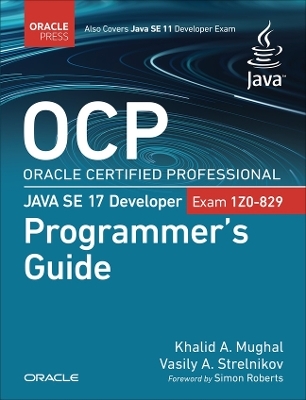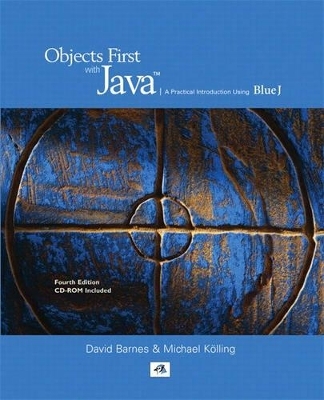
Objects First With Java
Pearson
978-0-13-700562-8 (ISBN)
- Titel erscheint in neuer Auflage
- Artikel merken
Its close integration with the BlueJ development environment allows this book to focus on key aspects of object-oriented software development from day one. BlueJ's clear visualization of classes and objects means that students can immediately appreciate the differences between them, and gain a much better understanding of the nature of an object than they would from simply reading source code. Unlike traditional textbooks, the chapters are not ordered by language features but by software development concepts. Language features are introduced as a response to the problems to be solved. A large number of different, interesting projects are used to provide variety and avoid the monotony of a running problem. The authors avoid the dangers of trying to teach all there is to know about each topic by using a spiral approach - introducing topics in a simple context early on and then revisiting later to deepen understanding. Throughout, the emphasis is on developing a practical approach to programming, with students encouraged to add code to existing programs rather than working with an intimidating sheet of blank paper.
Supplements:
Author's Companion Website: http://www.bluej.org/objects-first/ Includes Java Resource Links, Book Projects, Code Style Guide, Student Activities and more!
Instructor-only Resources (Registration required):
Power Point lecture slides
Solutions to exercises
Click on the "Resources" Tab above to view these downloadable files
Please Note
If you are using the U.S. Edition of this book, you can download instructor resources from http://www.pearsonhighered.com/educator/product/Objects-First-With-Java-A-Practical-Introduction-Using-BlueJ/9780136060864.page
Use your IRC login and password from website to log in.
David Barnes is a Lecturer in Computer Science at the University of Kent, in Canterbury, England. He has been teaching introductory programming for over 25 years, and has practical experience of a wide range of programming languages. He has been teaching object-oriented programming in Java for over 10 years. David is passionate about the excitement that is inherent in computer science and is actively involved in promoting it as a subject area to high-school children. In addition to computing education, his main research is in the area of software engineering. Michael Kölling is a Senior Lecturer at the Computing Laboratory, University of Kent, in Canterbury, England. He holds a PhD in computer science from Sydney University, and has worked in Australia, Denmark and the UK. Michael’s research interests are in the areas of object-oriented systems, programming languages, software tools, computing education. He has published numerous papers on object-orientation and computing education topics. Michael is one of the developers of BlueJ and, more recently, the Greenfoot platform.
Part 1 FOUNDATIONS OF OBJECT ORIENTATION
Chapter 1 Objects and classes
1.1 Objects and classes
1.2 Creating objects
1.3 Calling methods
1.4 Parameters
1.5 Data types
1.6 Multiple instances
1.7 State
1.8 What is in an object?
1.9 Object interaction
1.10 Source code
1.11 Another example
1.12 Return values
1.13 Objects as parameters
1.14 Summary
Chapter 2 Understanding class definitions
2.1 Ticket machines
2.1.1 Exploring the behavior of a naïve ticket machine
2.2 Examining a class definition
2.3 Fields, constructors, and methods
2.3.1 Fields
2.3.2 Constructors
2.4 Passing data via parameters
2.5 Assignment
2.6 Accessor methods
2.7 Mutator methods
2.8 Printing from methods
2.9 Summary of the naïve ticket machine
2.10 Reflecting on the design of the ticket machine
2.11 Making choices: the conditional statement
2.12 A further conditional-statement example
2.13 Local variables
2.14 Fields, parameters, and local variables
2.15 Summary of the better ticket machine
2.16 Self-review exercises
2.17 Reviewing a familiar example
2.18 Summary
Chapter 3 Object interaction
3.1 The clock example
3.2 Abstraction and modularization
3.3 Abstraction in software
3.4 Modularization in the clock example
3.5 Implementing the clock display
3.6 Class diagrams versus object diagrams
3.7 Primitive types and object types
3.8 The ClockDisplay source code
3.8.1 Class NumberDisplay
3.8.2 String concatenation
3.8.3 The modulo operator
3.8.4 Class ClockDisplay
3.9 Objects creating objects
3.10 Multiple constructors
3.11 Method calls
3.11.1 Internal method calls
3.11.2 External method calls
3.11.3 Summary of the clock display
3.12 Another example of object interaction
3.12.1 The mail system example
3.12.2 The this keyword
3.13 Using a debugger
3.13.1 Setting breakpoints
3.13.2 Single stepping
3.13.3 Stepping into methods
3.14 Method calling revisited
3.15 Summary
Chapter 4 Grouping objects
4.1 Grouping objects in flexible-size collections
4.2 A personal notebook
4.3 A first look at library classes
4.3.1 An example of using a library
4.4 Object structures with collections
4.5 Generic classes
4.6 Numbering within collections
4.7 Removing an item from a collection
4.8 Processing a whole collection
4.8.1 The for-each loop
4.8.2 The while loop
4.8.3 Iterating over a collection
4.8.4 Index access versus iterators
4.9 Summary of the notebook example
4.10 Another example: an auction system
4.10.1 The Lot class
4.10.2 The Auction class
4.10.3 Anonymous objects
4.10.4 Using collections
4.11 Flexible collection summary
4.12 Fixed-size collections
4.12.1 A log-file analyzer
4.12.2 Declaring array variables
4.12.3 Creating array objects
4.12.4 Using array objects
4.12.5 Analyzing the log file
4.12.6 The for loop
4.13 Summary
Chapter 5 More sophisticated behavior
5.1 Documentation for library classes
5.2 The TechSupport system
5.2.1 Exploring the TechSupport system
5.2.2 Reading the code
5.3 Reading class documentation
5.3.1 Interfaces versus implementation
5.3.2 Using library-class methods
5.3.3 Checking string equality
5.4 Adding random behavior
5.4.1 The Random class
5.4.2 Random numbers with limited range
5.4.3 Generating random responses
5.4.4 Reading documentation for parameterized classes
5.5 Packages and import
5.6 Using maps for associations
5.6.1 The concept of a map
5.6.2 Using a HashMap
5.6.3 Using a map for the TechSupport system
5.7 Using sets
5.8 Dividing strings
5.9 Finishing the TechSupport system
5.10 Writing class documentation
5.10.1 Using javadoc in BlueJ
5.10.2 Elements of class documentation
5.11 Public versus private
5.11.1 Information hiding
5.11.2 Private methods and public fields
5.12 Learning about classes from their interfaces
5.13 Class variables and constants
5.13.1 The static key word
5.13.2 Constants
5.14 Summary
Chapter 6 Well-behaved objects
6.1 Introduction
6.2 Testing and debugging
6.3 Unit testing within BlueJ
6.3.1 Using inspectors
6.3.2 Positive versus negative testing
6.4 Test automation
6.4.1 Regression testing
6.4.2 Automated checking of test results
6.4.3 Recording a test
6.4.4 Fixtures
6.5 Modularization and interfaces
6.6 A debugging scenario
6.7 Commenting and style
6.8 Manual walkthroughs
6.8.1 A high-level walkthrough
6.8.2 Checking state with a walkthrough
6.8.3 Verbal walkthroughs
6.9 Print statements
6.9.1 Turning debugging information on or off
6.10 Choosing a test strategy
6.11 Debuggers
6.12 Putting the techniques into practice
6.13 Summary
Chapter 7 Designing classes
7.1 Introduction
7.2 The world-of-zuul game example
7.3 Introduction to coupling and cohesion
7.4 Code duplication
7.5 Making extensions
7.5.1 The task
7.5.2 Finding the relevant source code
7.6 Coupling
7.6.1 Using encapsulation to reduce coupling
7.7 Responsibility-driven design
7.7.1 Responsibilities and coupling
7.8 Localizing change
7.9 Implicit coupling
7.10 Thinking ahead
7.11 Cohesion
7.11.1 Cohesion of methods
7.11.2 Cohesion of classes
7.11.3 Cohesion for readability
7.11.4 Cohesion for reuse
7.12 Refactoring
7.12.1 Refactoring and testing
7.12.2 An example of refactoring
7.13 Refactoring for language independence
7.13.1 Enumerated types
7.13.2 Further decoupling of the command interface
7.14 Design guidelines
7.15 Executing without BlueJ
7.15.1 Class methods
7.15.2 The main method
7.15.3 Limitations of class methods
7.16 Summary
Part 2 APPLICATION STRUCTURES
Chapter 8 Improving structure with inheritance
8.1 The DoME example
8.1.1 DoME classes and objects
8.1.2 DoME source code
8.1.3 Discussion of the DoME application
8.2 Using inheritance
8.3 Inheritance hierarchies
8.4 Inheritance in Java
8.4.1 Inheritance and access rights
8.4.2 Inheritance and initialization
8.5 DoME: adding other item types
8.6 Advantages of inheritance (so far)
8.7 Subtyping
8.7.1 Subclasses and subtypes
8.7.2 Subtyping and assignment
8.7.3 Subtyping and parameter passing
8.7.4 Polymorphic variables
8.7.5 Casting
8.8 The Object class
8.9 Autoboxing and Wrapper classes
8.10 The collection hierarchy
8.11 Summary
Chapter 9 More about inheritance
9.1 The problem: DoME’s print method
9.2 Static type and dynamic type
9.2.1 Calling print from Database
9.3 Overriding
9.4 Dynamic method lookup
9.5 Super call in methods
9.6 Method polymorphism
9.7 Object methods: toString
9.8 Protected access
9.9 Another example of inheritance with overriding
9.10 Summary
Chapter 10 Further abstraction techniques
10.1 Simulations
10.2 The foxes-and-rabbits simulation
10.2.1 The foxes-and-rabbits project
10.2.2 The Rabbit class
10.2.3 The Fox class
10.2.4 The Simulator class: setup
10.2.5 The Simulator class: a simulation step
10.2.6 Taking steps to improve the simulation
10.3 Abstract classes
10.3.1 The Animal superclass
10.3.2 Abstract methods
10.3.3 Abstract classes
10.4 More abstract methods
10.5 Multiple inheritance
10.5.1 An Actor class
10.5.2 Flexibility through abstraction
10.5.3 Selective drawing
10.5.4 Drawable actors: multiple inheritance
10.6 Interfaces
10.6.1 An Actor interface
10.6.2 Multiple inheritance of interfaces
10.6.3 Interfaces as types
10.6.4 Interfaces as specifications
10.6.5 A further example of interfaces
10.6.6 Abstract class or interface?
10.7 Summary of inheritance
10.8 Summary
Chapter 11 Building graphical user interfaces
11.1 Introduction
11.2 Components, layout, and event handling
11.3 AWT and Swing
11.4 The ImageViewer example
11.4.1 First experiments: creating a frame
11.4.2 Adding simple components
11.4.3 Adding menus
11.4.4 Event handling
11.4.5 Centralized receipt of events
11.4.6 Inner classes
11.4.7 Anonymous inner classes
11.5 ImageViewer 1.0: the first complete version
11.5.1 Image-processing classes
11.5.2 Adding the image
11.5.3 Layout
11.5.4 Nested containers
11.5.5 Image filters
11.5.6 Dialogs
11.6 ImageViewer 2.0: improving program structure
11.7 ImageViewer 3.0: more interface components
11.7.1 Buttons
11.7.2 Borders
11.8 Further extensions
11.9 Another example: SoundPlayer338
11.10 Summary
Chapter 12 Handling errors
12.1 The address-book project
12.2 Defensive programming
12.2.1 Client—server interaction
12.2.2 Argument checking
12.3 Server error reporting
12.3.1 Notifying the user
12.3.2 Notifying the client object
12.4 Exception-throwing principles
12.4.1 Throwing an exception
12.4.2 Exception classes
12.4.3 The effect of an exception
12.4.4 Unchecked exceptions
12.4.5 Preventing object creation
12.5 Exception handling
12.5.1 Checked exceptions: the throws clause
12.5.2 Catching exceptions: the try statement
12.5.3 Throwing and catching multiple exceptions
12.5.4 Propagating an exception
12.5.5 The finally clause
12.6 Defining new exception classes
12.7 Using assertions
12.7.1 Internal consistency checks
12.7.2 The assert statement
12.7.3 Guidelines for using assertions
12.7.4 Assertions and the BlueJ unit testing framework
12.8 Error recovery and avoidance
12.8.1 Error recovery
12.8.2 Error avoidance
12.9 Case study: text input/output
12.9.1 Readers, writers, and streams
12.9.2 The address-book-io project
12.9.3 Text output with FileWriter
12.9.4 Text input with FileReader
12.9.5 Scanner: reading input from the terminal
12.9.6 Object serialization
12.10 Summary
Chapter 13 Designing applications
13.1 Analysis and design
13.1.1 The verb/noun method
13.1.2 The cinema booking example
13.1.3 Discovering classes
13.1.4 Using CRC cards
13.1.5 Scenarios
13.2 Class design
13.2.1 Designing class interfaces
13.2.2 User interface design
13.3 Documentation
13.4 Cooperation
13.5 Prototyping
13.6 Software growth
13.6.1 Waterfall model
13.6.2 Iterative development
13.7 Using design patterns
13.7.1 Structure of a pattern
13.7.2 Decorator
13.7.3 Singleton
13.7.4 Factory method
13.7.5 Observer
13.7.6 Pattern summary
13.8 Summary
Chapter 14 A case study
14.1 The case study
14.1.1 The problem description
14.2 Analysis and design
14.2.1 Discovering classes
14.2.2 Using CRC cards
14.2.3 Scenarios
14.3 Class design
14.3.1 Designing class interfaces
14.3.2 Collaborators
14.3.3 The outline implementation
14.3.4 Testing
14.3.5 Some remaining issues
14.4 Iterative development
14.4.1 Development steps
14.4.2 A first stage
14.4.3 Testing the first stage
14.4.4 A later stage of development
14.4.5 Further ideas for development
14.4.6 Reuse
14.5 Another example
14.6 Taking things further
Appendices
A Working with a BlueJ project
B Java data types
C Java control structures
D Operators
E Running Java without BlueJ
F Configuring BlueJ
G Using the debugger
H JUnit unit-testing tools
I Javadoc
J Program style guide
K Important library classes
| Erscheint lt. Verlag | 21.8.2008 |
|---|---|
| Sprache | englisch |
| Maße | 236 x 208 mm |
| Gewicht | 964 g |
| Themenwelt | Informatik ► Programmiersprachen / -werkzeuge ► Java |
| Informatik ► Software Entwicklung ► Objektorientierung | |
| Mathematik / Informatik ► Informatik ► Web / Internet | |
| ISBN-10 | 0-13-700562-8 / 0137005628 |
| ISBN-13 | 978-0-13-700562-8 / 9780137005628 |
| Zustand | Neuware |
| Informationen gemäß Produktsicherheitsverordnung (GPSR) | |
| Haben Sie eine Frage zum Produkt? |
aus dem Bereich
